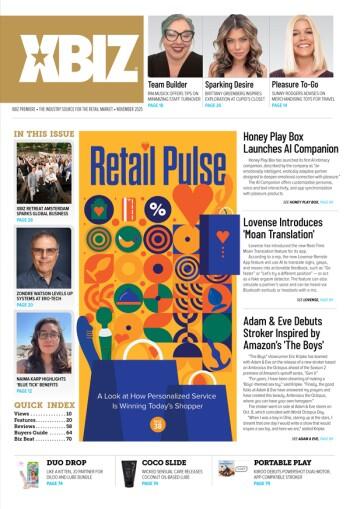As more consumers become interested in trying out different types of smart and app-connected sex toys, retailers and distributors can start exploring ways to advertise and display these products to increase sales in-store or online.
Unlike analog sex products, just displaying the physical product doesn’t do the product — or your sales — justice. It doesn’t fully describe the product, since a crucial part of the product is the software and other technology involved that completes the experience. By itself, it’s just a physical device that’s usually more expensive than analog devices, and to customers glancing quickly at a bunch of products online or in-store, it can be easily glossed over.
QR codes also allow customers to browse and get questions answered about a product without having to ask.
So how can you do these futuristic sex gadgets justice? Lioness, the company I co-founded, develops technologically advanced sex toys, so I have a few tips I can share on what has worked for us and what might prove effective for your business, whether with Lioness products or other brands.
1.Use QR codes for in-store retail displays for a low-cost, low-maintenance way to provide access to app demos and additional product information on your website.
Utilizing QR codes in your store can be beneficial for both customers and employees as well as increase in-store sales.
Recent adoption of technologies like QR codes, at least in the U.S., for things like viewing restaurant menus has made it easier to apply that technology across a number of different settings, including providing more information about a product or providing an easy link if a customer wants to demo an app from their phone at the store.
Having the app accessible with the physical product via a QR code can make it possible to demo high-tech sex toys to your customers while reducing the technological learning curve for employees who may have varying comfort levels with new technology. It also avoids using additional tablets with app-connected devices, which means there are fewer devices to charge and maintain and a lower likelihood of shoplifting. Instead, it can be as simple as posting a printed-out, laminated piece of paper next to the product, with a code to scan for more information. QR codes can be created almost instantly and for free online — all you need is a URL.
QR codes are not only beneficial for app downloads; they can also provide more information about any product in the store, information that a customer can access at any time. This can also reduce the burden of all retail staff having to know everything about every product at a moment’s notice — especially if certain smart products have upgradeable firmware, which means they add new features and functionalities over time for customers, so training materials may become out of date. QR codes also allow customers to browse and get questions answered about a product without having to ask, especially if employees are busy or if customers prefer to do some research on their own before making a purchase.
2. For online retail, display pictures of the physical product with the smartphone app.
As the saying goes, a picture is worth a thousand words. Having that image of a phone helps customers understand that the product comes with an app, and is an easy way for customers to get a quick, general understanding of that product versus devices without additional functionality from the range of different products offered. When selling products online, pictures of the device with the smartphone app should be more prominently featured in product listings.
Many high-tech sex toys have an app. Sometimes the app can be pretty central to the experience of the sex toy or even the main reason to buy that particular sex toy. The app may be for things like remote control or customizing patterns, or sometimes it’s for something different, like with Lioness and its ability to visualize individual arousal and orgasm in real time or after the fact. Regardless of what it is, it won’t be obvious what those features are from just looking at the physical device. Having information on the packaging may help, but there are also other ways to convey the full experience.
3. Ask the manufacturer for tips on how to answer customer questions about privacy and data security.
With any app-connected sex toy, it’s important for customers to know that it’s designed with privacy and security for anyone who uses it. Some customers will ask about this and will have different levels of familiarity with technology. If you’re someone who does not have a technological background, this may seem a large ask to learn. However, most people don’t need a PhD in computer science to get a general understanding of it. You can, and should, ask the manufacturer how any collected data is used. Also, be sure to ask for that information to be shared in “normal person speech” both to educate your staff and ensure that you’re comfortable with it.
4. Offer “buy now, pay later” options.
Smart sex toys can be more expensive than typical ones. Technologically advanced devices require more advanced electronics and teams of employees who specialize in different disciplines. Depending on the product, that could include electrical engineering, programming, AI experts, and security experts who support the initial development of the product and ongoing updates and maintenance.
All of this overhead can add up, which is why smart products can be more expensive than analog sex toys — more so if a toy is from a smaller manufacturer that doesn’t offer massive quantities yet. If all this overhead is to make something that is a value-add for the customer, delights them, and is not offered anywhere else, that price can be worthwhile for customers seeking out specific or novel experiences that analog sex toys don’t provide.
“Buy now, pay later” options have become more popular for consumers in recent years. Different options are available both online and in-store and can help make premium purchases more feasible for people who want to break up the total cost into smaller payments. Some options such as Klarna offer different ways to pay, from splitting the payment into four biweekly payments to paying nothing upfront and paying within 30 days. “Buy now, pay later” companies evaluate each transaction that comes through and take on the risk of those payments, reducing the risk for the retailer of a no-show payment. The retailer is usually paid in full so there isn’t a delay in receiving the payment.
5. Offer a variety of smart sex toys and understand the differences between them.
“Smart” does not mean the same thing for all devices, and customers will be looking for different things. Customers who know exactly what they want will probably buy directly online. You want to help people discover new things and show how different smart devices fulfill different needs for consumers. While some may be looking for a remote-control vibrator to bond with someone over a long distance, others may be looking for new and novel experiences and may be interested in trying out products that connect with VR or audio pornography. Others may be looking to tinker or answer a question for themselves and be interested in something with data and biofeedback capabilities.
Do you have any tips to share that have worked for your business? Something that hasn’t? Let me know! I’d love to hear about and share more ways to sell smart sex toys in the broader marketplace.
Liz Klinger is the CEO and co-founder of Lioness, a women-led company and a recognized pioneer and innovator in the sextech and femtech industries.









